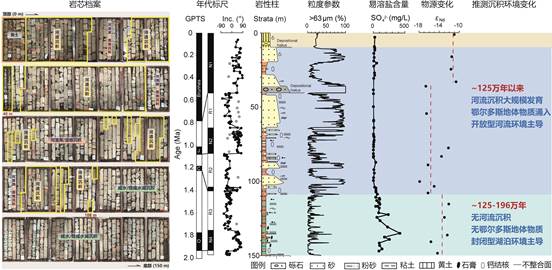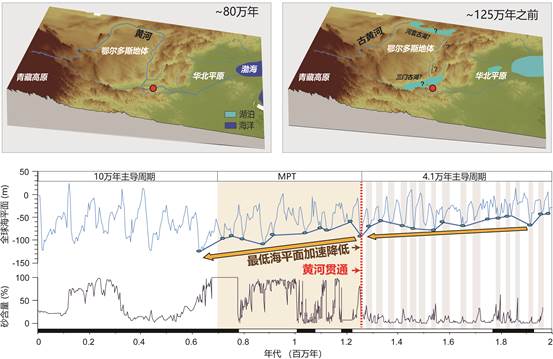the yellow river, the sixth longest river in the world and the second longest river in china, is the cradle of chinese civilization. the study on the formation and evolution history of the modern yellow river system and its driving mechanism will provide important evidence for understanding how the structure-climate interaction shaped the geographical environment pattern of china.
the formation of "ji" bay and the passage of sanmenxia to the east into the sea are important symbols of the formation of the modern yellow river system. however, due to the lack of complete sedimentary records of river evolution in the middle reaches of the yellow river, the frequent rivers diversion in the lower reaches, and the first-hand information on the formation of the modern yellow river system is not readily available, there are still different opinions about the formation age of the modern yellow river system, such as ~ 150,000 years, no later than 880,000 years, no later than 1.2 million years, ~ 1.5 to 1.6 million years, and ~5 million years, etc., and there are also different understandings about the formation reasons.
sanmenxia is the last valley on the mainstream of the yellow river, and is the throat connecting the middle and lower reaches of the yellow river and plays a key role in the research of the formation and evolution of the yellow river system. in the past, the domestic and foreign scientists focused exclusively on the outcrop section in the sanmenxia basin and surrounding areas to carry out the research, but since the late cenozoic strata outcropped discontinuously, often within a few kilometers from multiple research profiles short section of the patchwork, combined with complex structure, vegetation coverage is high, the formation of weathering, docking in profile, the division of sedimentary facies, dating is uncertainty, it is an important reason for the existing differences in understanding.
coordinated and sponsored by academician chen fahu, prof. wang xin, prof. hu zhenbo, prof. nie junsheng, prof. pan baotian, and the research team on geomorphic evolution and cenozoic environment of the key laboratory of western china environment, ministry of education, college of earth and environmental sciences, lanzhou university, with the china earthquake administration institute of geology, china seismological bureau first monitoring center, japan island university, china university of geosciences (wuhan), and other units, drilling and implemented in the center of the sanmenxia basin environment cooperation study, to obtain the complete core files, well versed in sanmenxia yellow river history through comparing with the edge of basin outcrop section, it is clear that the first appearance of channel sediments at 108 m of the core is the oldest imprint left by the yellow river in sanmenxia area.

fig. 1 record of core and sedimentary environment changes in smx19 borehole
the results of systematic sedimentology, paleomagnetic dating, provenance analysis (sr-nd isotope & heavy mineral assemblage), and paleo-environmental proxy index recording (particle size & soluble salt) show that: since the beginning of ~ 1.25 million years, the river sediments in sanmenxia basin began to develop on a large scale, the detrital materials in the upstream ordos terrane began to flood in large quantities, and the sedimentary environment experienced a significant transformation from the closed saltwater to the open river environment. carried out a comprehensive new geomorphic evidence analysis, professor pan baotian's team issued a series of evidence of the yellow river terraces in the middle reaches of the yellow river, marginal sea sediment evidence published in recent years, and the research team on the modern yellow river water body were ~ 1.25 million began to form, the acceleration of global climate sea level during the transitional period of middle pleistocene has an important influence on the forming of new knowledge. the results clarify the formation age of the modern yellow river and provide a new perspective for the study of the formation and evolution history of the world's major rivers and the development model of the river.

fig. 2 the formation process of the modern yellow river and its comparison with global sea level change
the study is titled "did the modern yellow river form at the mid-pleistocene transition? "was published as an article in the prestigious journal science bulletin on august 15 and selected as the cover article of volume 15 of 2022. professor wang xin, the college of earth and environmental sciences, lanzhou university, is the first author and corresponding author of the paper. hu gang, associate professor of the institute of geology, china earthquake administration, is the co-corresponding author. this research was supported by the basic research funds project of lanzhou university (lzujbky-2021-ey12), the national natural science foundation of china (42072211), the second comprehensive scientific investigation and research project of qinghai-tibet plateau (2019qzkk0602), and the basic research business special project of central public welfare research institutes (igcea) 2008) co-funding.
link to article: https://www.sciencedirect.com/science/article/abs/pii/s2095927322002365?via=ihub